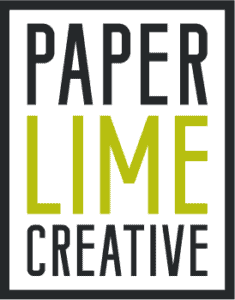Earlier this year I mentioned that my husband and I spent 2019 working towards a zero-waste lifestyle and since sustainability and care for the environment are important to me, I started thinking about how Paper Lime Creative affects the planet.
Where does Paper Lime’s paper come from? What happens after our paper products have outlived their usefulness? Are our beautiful materials thrown out? Recycled? And is the pulp and paper industry sustainable? What are other businesses doing?

There is a LOT of information out there and the stats and graphs you see when you start researching these things depend on who’s behind the information (the paper company? The government? An independent source?, so I decided to find answers to the three biggest questions:
- Where does paper come from?
- How is the paper disposed of?
- Is paper actually sustainable?
There’s a lot to unpack here, so let’s get started.
Where Does Our Paper Come From?
In Canada, paper is made from sawmill residues (aka sawdust) and recycled paper. The sawmill residue only comes from companies that are harvesting trees sustainably, and they have to have accreditation to prove it. The sawdust can also come from tree farm harvested trees.
For forest harvesters their accreditation comes from the Forest Stewardship Council® (FSC®), which helps protect animal habitat, indigenous peoples’ rights, workers’ rights, and Canada’s forests in general.
Having that certification means that they are conducting business ethically. That is super awesome for people to know! Canada is famous for its forests and it’s great that our businesses are taking care of them. It also makes sense for pulp and paper companies to actually be sustainable. If they wiped out huge forests, they’d be out of business pretty quick.
So, paper companies harvest trees in specific areas that “allow trees to be harvested sustainably… For each tree that is cut down, several are planted or naturally regrown in its place, at a rate that keeps the environment stable.” As more people are questioning the paper industry in a time of “going paperless” companies like Domtar are going to great lengths to show that they care about the environment–Just look at all their articles about “Environmental Responsibility”
How is Paper Disposed Of?
You’ve decided to rebrand, but that means your old business cards, brochures, pamphlets, etc. are all getting tossed. But all your high-quality, glossy, thick stock paper can be recycled up to 6 times before it finally ends up in a landfill.
If it gets put into a recycling bin, chances are good that it will turn into newspaper, toilet paper rolls, food packaging, and eventually into a cardboard box. Canadians are actually really good at recycling about 70% of us do it. But not all paper can be recycled. It needs to be clean, or “contaminant free.” Even a coffee-stained Post-it note can contaminate an entire ton of paper. Make sure you’re throwing those greasy pizza boxes, tissues, and take-out containers straight into the trash. That ensures the paper you throw in the blue bin ends up being recycled.

And Finally, Is Paper Truly Sustainable?
I would love for the answer to this question to be yes, but based on the mountains of reports, we are just not there yet. The fuels that power the machines that process the wood, power buildings and vehicles that are involved in the process all use petroleum products. I don’t think we are going to start hauling logs with Teslas any time soon.
However, every year there is more and more pressure on the industry to become carbon neutral and regular people are more aware of their impact on the planet than ever. I’m optimistic that things will keep changing for the better!
Sustainability is always a work in progress. We are definitely heading in the right direction. It’s important when getting your brand out to the world that you are printing what you need, and distributing it strategically to get in the right people’s hands. Add value with your marketing pieces and they will hang around for longer!
